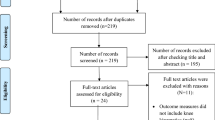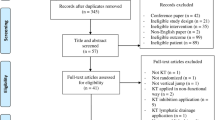Abstract
Purpose
Poor lower extremity kinematics have been linked with lower extremity injuries. One of the main contributing factors in the development of poor lower extremity kinematics is hip muscle weaknesses. This systematic review aimed to summarize the literature related to the effects of hip muscle strengthening on lower extremity kinematics among healthy subjects.
Methods
A search for randomized controlled trials (RCTs) was conducted using the following databases: Cochrane, Web of Science, MEDLINE, PEDro and EBSCO. The selected studies had to distinguish the effects of hip muscle strengthening in healthy subjects, as compared to non-intervention or other kinds of intervention, and investigate at least one of the lower extremity kinematic factors. Two researchers performed study screening for obtaining the quality assessment scores in each included study using the PEDro scale. Statistical heterogeneity was tested using the Chi2 test and I2 statistic.
Results
Five studies were entered to review. There was level 1b or moderate evidence based on one “high” quality study that demonstrated hip muscle strengthening intervention was effective in the improvement of lower extremity kinematics.
Conclusion
It is difficult to make any definitive conclusions based on the results of this review and further research is needed. However, it should be considered that prescription hip muscle strengthening interventions alone maybe has a small effect on lower extremity kinematics in healthy subjects.

Similar content being viewed by others
References
Bell DR, Padua DA, Clark MA (2008) Muscle strength and flexibility characteristics of people displaying excessive medial knee displacement. Arch Phys Med Rehabil 89(7):1323–1328
Dempsey AR et al (2007) The effect of technique change on knee loads during sidestep cutting. Med Sci Sports Exerc 39(10):1765–1773
McLean SG, Lipfert SW, Van Den Bogert AJ (2004) Effect of gender and defensive opponent on the biomechanics of sidestep cutting. Med Sci Sports Exerc 36(6):1008
Rabin A, Kozol Z (2010) Measures of range of motion and strength among healthy women with differing quality of lower extremity movement during the lateral step-down test. J Orthop Sports Phys Ther 40(12):792–800
Chuter VH, de Jonge XAJ (2012) Proximal and distal contributions to lower extremity injury: a review of the literature. Gait Posture 36(1):7–15
Noehren B et al (2012) Proximal and distal kinematics in female runners with patellofemoral pain. Clin Biomech 27(4):366–371
Stefanyshyn DJ et al (2006) Knee angular impulse as a predictor of patellofemoral pain in runners. Am J Sports Med 34(11):1844–1851
Nakagawa TH et al (2012) Trunk, pelvis, hip, and knee kinematics, hip strength, and gluteal muscle activation during a single-leg squat in males and females with and without patellofemoral pain syndrome. J Orthop Sports Phys Ther 42(6):491–501
MacLean CL, Davis IS, Hamill J (2008) Short- and long-term influences of a custom foot orthotic intervention on lower extremity dynamics. Clin J Sport Med 18(4):338–343
Hewett TE et al (2005) Biomechanical measures of neuromuscular control and valgus loading of the knee predict anterior cruciate ligament injury risk in female athletes: a prospective study. Am J Sports Med 33(4):492–501
Alentorn-Geli E et al (2009) Prevention of non-contact anterior cruciate ligament injuries in soccer players. Part 1: mechanisms of injury and underlying risk factors. Knee Surg Sports Traumatol Arthrosc 17(7):705–729
Milner CE, Hamill J, Davis IS (2010) Distinct hip and rearfoot kinematics in female runners with a history of tibial stress fracture. J Orthop Sports Phys Ther 40(2):59–66
Werner RA et al (2010) Risk factors for plantar fasciitis among assembly plant workers. PM&R 2(2):110–116
Hess GW (2010) Achilles tendon rupture: a review of etiology, population, anatomy, risk factors, and injury prevention. Foot Ankle Spec 3(1):29–32
Snyder KR et al (2009) Resistance training is accompanied by increases in hip strength and changes in lower extremity biomechanics during running. Clin Biomech 24(1):26–34
Earl JE, Hoch AZ (2011) A proximal strengthening program improves pain, function, and biomechanics in women with patellofemoral pain syndrome. Am J Sports Med 39(1):154–163
Nakagawa TH et al (2008) The effect of additional strengthening of hip abductor and lateral rotator muscles in patellofemoral pain syndrome: a randomized controlled pilot study. Clin Rehabil 22(12):1051–1060
Tyler TF et al (2006) The role of hip muscle function in the treatment of patellofemoral pain syndrome. Am J Sports Med 34(4):630–636
Dix J et al (2019) The relationship between hip muscle strength and dynamic knee valgus in asymptomatic females: a systematic review. Phys Ther Sport 37:197–209
Powers CM (2010) The influence of abnormal hip mechanics on knee injury: a biomechanical perspective. J Orthop Sports Phys Ther 40(2):42–51
Noyes FR et al (2011) A training program to improve neuromuscular indices in female high school volleyball players. J Strength Condit Res 25(8):2151–2160
Willy RW, Davis IS (2011) The effect of a hip-strengthening program on mechanics during running and during a single-leg squat. J Orthop Sports Phys Ther 41(9):625–632
Palmer K, Hebron C, Williams JM (2015) A randomised trial into the effect of an isolated hip abductor strengthening programme and a functional motor control programme on knee kinematics and hip muscle strength. BMC Musculoskelet Disord 16:105
McCurdy K et al (2012) The effect of short-term resistance training on hip and knee kinematics during vertical drop jumps. J Strength Cond Res 26(5):1257–1264
McCurdy K et al (2012) The effect of short-term resistance training on hip and knee kinematics during vertical drop jumps. J Strength Condit Res 26(5):1257–1264
Palmer K, Hebron C, Williams JM (2015) A randomised trial into the effect of an isolated hip abductor strengthening programme and a functional motor control programme on knee kinematics and hip muscle strength. BMC Musculoskelet Disord 16(1):105
Peters JS, Tyson NL (2013) Proximal exercises are effective in treating patellofemoral pain syndrome: a systematic review. Int J Sports Phys Ther 8(5):689
Santos TR et al (2015) Effectiveness of hip muscle strengthening in patellofemoral pain syndrome patients: a systematic review. Braz J Phys Ther 19(3):167–176
Shamseer L et al (2015) Preferred reporting items for systematic review and meta-analysis protocols (PRISMA-P), elaboration and explanation. BMJ 2015:349
Coqueiro KR et al (2005) Analysis on the activation of the VMO and VLL muscles during semisquat exercises with and without hip adduction in individuals with patellofemoral pain syndrome. J Electromyogr Kinesiol 15(6):596–603
Elkins MR et al (2013) Growth in the physiotherapy evidence database (PEDro) and use of the PED ro scale. BMJ Publishing Group Ltd and British Association of Sport and Exercise Medicine
Sackett D et al (2000) Evidence-based medicine: how to practice and teach EBM, 2nd edn. Churchill Livingstone, Edinburgh
Higgins JP et al (2011) The Cochrane Collaboration’s tool for assessing risk of bias in randomised trials. BMJ 343:d5928
Herman DC et al (2008) The effects of strength training on the lower extremity biomechanics of female recreational athletes during a stop-jump task. Am J Sports Med 36(4):733–740
Jafarnezhadgero A et al (2019) Effects of corrective training on drop landing ground reaction force characteristics and lower limb kinematics in older adults with genu valgus: a randomized controlled trial. J Aging Phys Act 27(1):9–17
McHugh ML (2012) Interrater reliability: the kappa statistic. Biochemia medica 22(3):276–282
Alzahrani AM et al (2021) Is hip muscle strength associated with dynamic knee valgus in a healthy adult population? A systematic review. Int J Environ Res Public Health 18(14):7669
Malloy P et al (2016) Hip external rotator strength is associated with better dynamic control of the lower extremity during landing tasks. J Strength Cond Res 30(1):282
Irct2017011732008N (2017) Training effect with EMG biofeedback on patella femoral pain syndrome. http://www.who.int/trialsearch/Trial2.aspx?TrialID=IRCT2017011732008N1.
Lawrence RK III et al (2008) Influences of hip external rotation strength on knee mechanics during single-leg drop landings in females. Clin Biomech 23(6):806–813
Irct20120411009440N (2018) The effect of gluteus medius and quadratus lumborum dry needling in patients with patellofemoral pain syndrome. http://www.who.int/trialsearch/Trial2.aspx?TrialID=IRCT20120411009440N20
Cashman GE (2012) The effect of weak hip abductors or external rotators on knee valgus kinematics in healthy subjects: a systematic review. J Sport Rehabil 21(3):273–284
Frank C, Kobesova A, Kolar P (2013) Dynamic neuromuscular stabilization and sports rehabilitation. Int J Sports Phys Ther 8(1):62
Page P, Frank C, Lardner R (2010) Assessment and treatment of muscle imbalance: the Janda approach. Human kinetics
Conneely M, O'Sullivan K (2008) Gluteus maximus and gluteus medius in pelvic and hip stability: isolation or synergistic activation? Physiotherapy Ireland 29(1):6–10
Pantano KJ et al (2005) Differences in peak knee valgus angles between individuals with high and low Q-angles during a single limb squat. Clin Biomech 20(9):966–972
Joseph M et al (2008) Knee valgus during drop jumps in National Collegiate Athletic Association Division I female athletes: the effect of a medial post. Am J Sports Med 36(2):285–289
Chappell JD, Limpisvasti O (2008) Effect of a neuromuscular training program on the kinetics and kinematics of jumping tasks. Am J Sports Med 36(6):1081–1086
Barendrecht M et al (2011) Neuromuscular training improves knee kinematics, in particular in valgus aligned adolescent team handball players of both sexes. J Strength Condit Res 25(3):575–584
Dempsey AR et al (2009) Changing sidestep cutting technique reduces knee valgus loading. Am J Sports Med 37(11):2194–2200
Greska EK et al (2012) A feedback inclusive neuromuscular training program alters frontal plane kinematics. J Strength Cond Res 26(6):1609
Dowling AV et al (2010) Shoe-surface friction influences movement strategies during a sidestep cutting task: implications for anterior cruciate ligament injury risk. Am J Sports Med 38(3):478–485
Fedie R et al (2010) Effect of attending to a ball during a side-cut maneuver on lower extremity biomechanics in male and female athletes. Sports Biomech 9(3):165–177
Chaudhari AM, Hearn BK, Andriacchi TP (2005) Sport-dependent variations in arm position during single-limb landing influence knee loading: implications for anterior cruciate ligament injury. Am J Sports Med 33(6):824–830
Author information
Authors and Affiliations
Corresponding author
Ethics declarations
Conflict of interest
The authors declare that the research was conducted without any commercial or financial relationships that could be construed as a potential conflict of interest upon submitting this article.
Additional information
Publisher's Note
Springer Nature remains neutral with regard to jurisdictional claims in published maps and institutional affiliations.
Supplementary Information
Below is the link to the electronic supplementary material.
Rights and permissions
About this article
Cite this article
Mozafaripour, E., Bayattork, M. & Shahrbanian, S. Can hip muscle strengthening interventions improve lower extremity kinematics among healthy subjects? A systematic review of randomized controlled trials. Sport Sci Health 19, 453–460 (2023). https://doi.org/10.1007/s11332-022-00953-w
Received:
Accepted:
Published:
Issue Date:
DOI: https://doi.org/10.1007/s11332-022-00953-w




